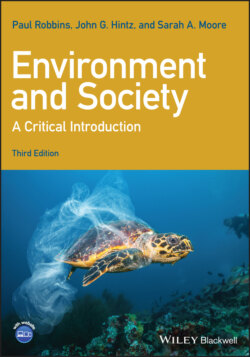Читать книгу Environment and Society - Paul Robbins - Страница 29
Carrying Capacity and the Ecological Footprint
ОглавлениеOn the other side of the equation, assuming agreement might be reached on how to measure impact per person, the degree to which each such impact is “too much” is also a matter of uncertainty. Just as IPAT and its variations predict future impacts of society on nature, the notion of carrying capacity is often invoked to signal the limits beyond which a local area can no longer absorb population. Carrying capacity is the number of people that could theoretically be sustained in one area (or the Earth) over an indeterminate amount of time, assuming a particular lifestyle (level of technology and consumption).
Carrying Capacity The theoretical limit of population (animal, human, or otherwise) that a system can sustain
Ecological Footprint The theoretical spatial extent of the earth’s surface required to sustain an individual, group, system, organization; an index of environmental impact
Forest Transition Theory A model that predicts a period of deforestation in a region during development, when the forest is a resource or land is cleared for agriculture, followed by a return of forest when the economy changes and population outmigrates and/or becomes conservation-oriented
It has been estimated, for example, that if we calculate carrying capacity based on an assumption that all people lived like people do in the United States, the Earth could sustain only two billion people, or less than one-third of the world’s current population (Chambers et al. 2002). If this is taken seriously, we might have to ask how we can possibly decide who should be allowed to live at what standard of living. In other words, is it reasonable to insist that China not develop any further, so that levels of consumption in the United States and Europe can remain the same? Should people in North America demand that India limit its growth so that North Americans (in the United States and Canada) can maintain their own standard of living? For many people, these extremely problematic ethical questions have led to a desire to decrease their own impact on the environment – their ecological footprint.
The idea of an ecological footprint analysis is not so much to define the potential of an area to support a particular number of people at a particular standard (although it can do that), but rather to estimate the total area of productive land and water required to produce the resources for and assimilate the waste from a given population. While this can be done at multiple scales – some people use it to analyze the environmental impacts of entire urban areas, or even countries – many people find it useful to estimate how their own daily practices of eating, showering, driving, using the bathroom, washing their clothes, etc. affect the environment. There are many websites available that allow users to enter their own data and receive a number representing their impact on the environment. Of course, you can always view this data with a degree of skepticism, but for many people it is a real eye-opener (“my restaurant dinners add 20 square kilometers to my footprint!”). So even if human population will never truly “exhaust” the Earth, it is reasonable to ask what quality of life might be expected in specific places with large populations (e.g. Phoenix, Arizona) to ask what obligations the wealthy have to the Earth upon which they tread so heavily, and to consider policies that might bend the demographic curve (see Box 2.1 ).
